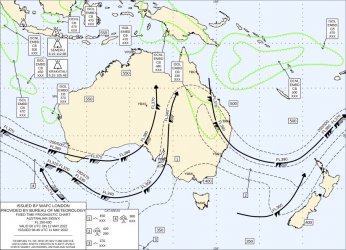AviatorInsight
Established Member
- Joined
- Oct 5, 2016
- Posts
- 1,396
Jet streams are usually around the 150kt mark. As shown in the photo below, this is the high level significant weather chart which is just one of the charts that are given as part of the flight plan package. This particular chart was issued yesterday afternoon and valid from 10am today.I’m not sure what rates as a strong wind up at FL400 but this mornings QF611 BNE - MEL service had a few bumps in the cruise
If you have a look along the BNE-MEL track there is a fairly strong jet stream sitting at 38,000ft. It's speed there is only about 120kts. I don't have yesterday's charts for this morning's flight but this jet is moving eastward so it's possible that it could have been a bit stronger earlier.
There is also associated moderate turbulence along that track with the occasional severe turbulence up to 42,000ft that sits between BNE and SYD which explains the bumps in the cruise.

















